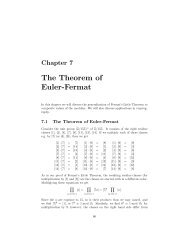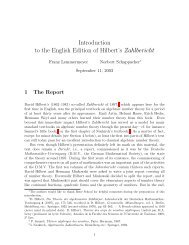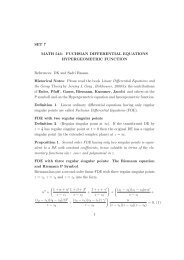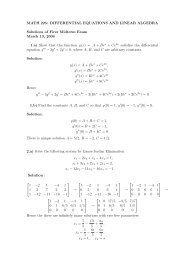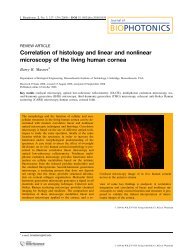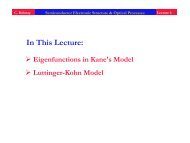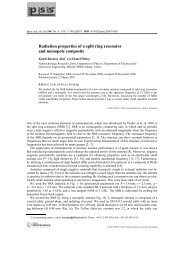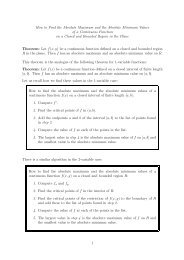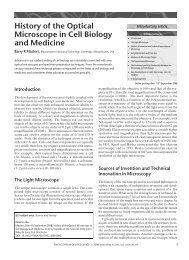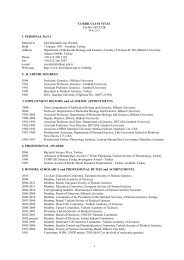Jump processes in surface diffusion - Bilkent University - Faculty of ...
Jump processes in surface diffusion - Bilkent University - Faculty of ...
Jump processes in surface diffusion - Bilkent University - Faculty of ...
You also want an ePaper? Increase the reach of your titles
YUMPU automatically turns print PDFs into web optimized ePapers that Google loves.
58 G. Antczak, G. Ehrlich / Surface Science Reports 62 (2007) 39–61<br />
Fig. 60. Schematic <strong>of</strong> different types <strong>of</strong> jump <strong>processes</strong> for an adatom on<br />
W(211) [126]. β R denotes rebound transition.<br />
Fig. 58. Normal Arrhenius plot for β double jumps <strong>of</strong> W adatom on<br />
W(211) [126].<br />
Fig. 61. Rate <strong>of</strong> rebound jumps, obta<strong>in</strong>ed as the difference between the<br />
sum <strong>of</strong> s<strong>in</strong>gle plus double jumps and total jump rate extrapolated from low<br />
temperatures [129].<br />
Fig. 59. Arrhenius plot for the sum <strong>of</strong> all jump rates measured for W adatom<br />
on W(211). For temperatures ≥310 K, rate falls below l<strong>in</strong>ear plot [126].<br />
such a rebound transition, and it is therefore not detected <strong>in</strong><br />
the normal <strong>diffusion</strong> measurements, but rebounds were found <strong>in</strong><br />
molecular dynamics simulations <strong>in</strong> 1989 by DeLorenzi [127],<br />
and a few years later by Sanders and DePristo [128] and Ferrón<br />
et al. [113].<br />
A way to measure such rebounds has recently been<br />
discovered. Antczak [129] has po<strong>in</strong>ted out that the sum <strong>of</strong> the<br />
measured jump rates has to be subtracted from the straightl<strong>in</strong>e<br />
Arrhenius plot obta<strong>in</strong>ed by extrapolat<strong>in</strong>g the sum from<br />
low temperatures. The rebound rate so obta<strong>in</strong>ed is shown<br />
<strong>in</strong> Fig. 61; it has an activation energy <strong>of</strong> 1.03 ± 0.06 eV<br />
and a frequency prefactor <strong>of</strong> 1.40(×10.3 ±1 ) × 10 16 s −1 , and<br />
thus lies midway between s<strong>in</strong>gle and double jumps. What<br />
is surpris<strong>in</strong>g is that rebounds were not detected <strong>in</strong> twodimensional<br />
<strong>diffusion</strong> on W(110) at all, suggest<strong>in</strong>g it may be an<br />
effect tied to the channelled structure <strong>of</strong> W(211) that is <strong>in</strong>volved<br />
<strong>in</strong> these transitions. However, they have been seen previously <strong>in</strong><br />
simulations <strong>of</strong> self-<strong>diffusion</strong> on the Cu(111) plane [113].<br />
It should be noted that long jumps are not limited to the<br />
movement <strong>of</strong> s<strong>in</strong>gle atoms. As is apparent from Fig. 62,<br />
long jumps were observed by Wang [130,131] for clusters <strong>of</strong><br />
iridium atoms on Ir(111), and for the large organic molecules<br />
decacyclene and hexa-tert-butyl-decacyclene by Schunack<br />
et al. [132]. However, <strong>in</strong>formation about the k<strong>in</strong>etics <strong>of</strong> these<br />
<strong>processes</strong> is limited and cry<strong>in</strong>g for more work.<br />
F<strong>in</strong>ally, it should be said that theoretical predictions about<br />
long jumps have been very important <strong>in</strong> po<strong>in</strong>t<strong>in</strong>g to their<br />
contributions <strong>in</strong> <strong>diffusion</strong>. However, even the limited number<br />
<strong>of</strong> experiments done so far have already revealed that these<br />
transitions are rather more varied and more significant than<br />
predicted, especially at low temperatures.<br />
4. Summary<br />
This survey should make it clear that a whole variety <strong>of</strong><br />
different jumps contributes to <strong>surface</strong> <strong>diffusion</strong> on metals. Atom<br />
exchange <strong>processes</strong> are <strong>of</strong> course very much affected by the<br />
chemistry <strong>of</strong> the <strong>in</strong>teract<strong>in</strong>g partners, but have so far only<br />
been observed <strong>in</strong> experiments with fcc metals. On channelled<br />
<strong>surface</strong>s the direction favoured <strong>in</strong> <strong>diffusion</strong> is still puzzl<strong>in</strong>g.



